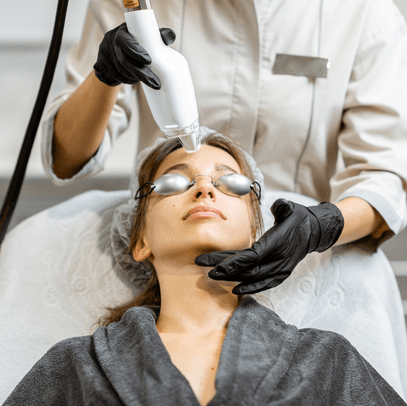When we talk about encouraging collagen growth, the repair of scar tissue and sun damage, are we also looking for a quick fix? What would you think if that ‘quick fix’, could cause more long term damage than what the initial treatment was originally prescribed for?
It is important to understand how it works, its underlying mechanisms and the trade-off you are making for a temporarily tight, resurfaced skin. Go with caution – or better still, don’t go at all.
Lasers work by causing various amounts of damage to the skin, with Ablative Lasers being the most powerful. This laser works by removing the epidermis (top layer of your skin) and part of your dermis (second layer of your skin) by superheating the water in the skin. This causes vaporization of skin cells and the body responds by making new skin.
It has also been marketed to stimulate the growth of new collagen fibres in the dermis, but let’s look at the reality of this. The dermis is making new collagen fibres and skin cells in order to rebuild your epidermis because it must, for your survival. The primary function of the epidermis is to protect you against environmental factors, regulate body temperature and create a waterproof defensive barrier.
With these aggressive treatments, they seem to be only focused on only the immediate look and feel of your skin, not how you will look in consequent years. If it’s so damaging, why does your skin look better after laser? Because, they are making a new surface to the skin to make you look younger. However, forcing repair accelerates telomere shortening, so your younger-looking skin is actually made with older cells. Your youthful appearance will be shorter-lived. You’ve aged yourself faster.
Remember the Hayflick Limit? Cells can only divide a certain number of times before they die. And in the lead up to death these old cells (they have critically short telomeres) don’t function well: no collagen, no elastin, the pigment goes haywire etc. So forcing your cells to divide faster is without any doubt forcing them to age faster. What forces cell division…Repair! And, is that lovely ‘tight’ feeling is the inflammation that has been caused detrimental?
DAMAGE IS NOT THE ANSWER!
I’ve seen some permanent damage caused by laser procedures. In my mind, it is one of the treatments that can go very, very wrong. The thing that makes lasers so powerful and also so dangerous is the tiny fluctuations in how light and heat are manipulated — and the exact wavelength and energy — it can be the difference between giving you perfect skin and a catastrophic burn or hyper or hypopigmentation. The laser itself means very little, compared with the person on the other end of the laser who’s programming the settings and manually putting it on your face.
So, what should I look for in an anti-aging treatment?
If you are still wanting a laser treatment, a non-ablative laser is touted as a gentler option than its ablative counterpart because they do not burn the surface of the skin. They direct their energy much lower into the deeper tissue and cause damage there. The visible results are slower. This is possible because your skin stem cells are in your epidermis and therefore are not damaged with this treatment, forcing them to proliferate (make loads of new skin cells).
You need to be looking for treatments that do not damage the surface of the skin. Micro-needling treatments which target beneath the epidermis and do not remove the top layer of skin, LED light therapy and micro-current treatments are all my go-to’s. Support your skin at home with great hydration, peptide, vitamins, telomere support and an SPF. These will all work together to support not speed up the ageing process.
